Observations and lessons learned from my first time planting bare-root fruit trees and shrubs in the thick clay of Eastern Ontario (Canadian Hardiness Zone 5b).
The plot
The area of land I was working with is immediately below road-side power lines on the edge of a wide ditch along a country road. Additionally, the plot had been maintained as a close-cropped lawn for at least 1-2 decades prior and so the soil was not ideal. In terms of sun, the plot (which is about 6' wide by about 40' long) was nestled between a thick Balsam Fir and a Large Eastern White Pine. The Balsam fir was very thick and casted shade in the evenings. The Eastern White Pine, although large, had been thinned prior due to disease and so it casted very limited shade. So in conclusion, considerations included: maximum height of mature plant, road-salt tolerance, sun/shade preferences, and ability to break apart the clay.Planning
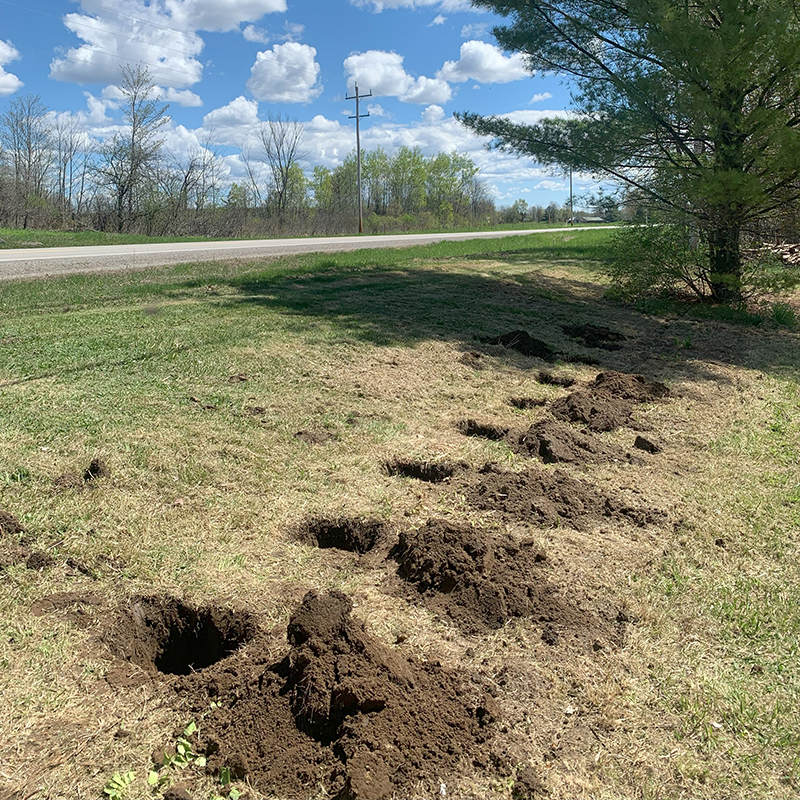 In addition to creating biodiversity and a food source, another motivation in the planning was to create a hedgerow and windbreak to protect a future garden downslope. I was also interested in creating privacy from the road. Additionally, I was also worried about the salt run-off from the country road that was sloped slightly above the plot. My idea was to have a row of the hardier plants (Seabuckthorn and Aronia) closest to the road, with a row of Elderberry downslope from them, spaced off-center from the previous row. The plot itself was unsuitable for a lot of different varieties, but I felt confident these 3 hardy plants would be able to tolerate the conditions and soil. I plotted everything meticulously and observed the site at various times of day to ensure that there was no excessive shading for long periods of time. There were two planned holes that I observed would get about 3 hours of shade more a day than the rest and decided to plan this area for the Aronia as I read that they were able to tolerate some shade while still producing fruit.
In addition to creating biodiversity and a food source, another motivation in the planning was to create a hedgerow and windbreak to protect a future garden downslope. I was also interested in creating privacy from the road. Additionally, I was also worried about the salt run-off from the country road that was sloped slightly above the plot. My idea was to have a row of the hardier plants (Seabuckthorn and Aronia) closest to the road, with a row of Elderberry downslope from them, spaced off-center from the previous row. The plot itself was unsuitable for a lot of different varieties, but I felt confident these 3 hardy plants would be able to tolerate the conditions and soil. I plotted everything meticulously and observed the site at various times of day to ensure that there was no excessive shading for long periods of time. There were two planned holes that I observed would get about 3 hours of shade more a day than the rest and decided to plan this area for the Aronia as I read that they were able to tolerate some shade while still producing fruit.Preparing the area
The bare-root plants I ordered were due to arrive at a specific date and I had a few months in advance to prepare. Despite their arrival in early spring, there was significant lawn growth, which I allowed to grow out until a day prior to the bare-root plants arriving from the nursery in the mail. The day prior to their arrival I close-cropped the section of lawn and raked the lawn clippings into a pile to be reused later. Due to time constraints, I knew I was not going to have enough time to dig the holes on the same day of planting, and so I did this in advance. It took a few hours to cut through the thick clay and I had to remove several torso-sized boulders. Each hole was about double the size that I needed, to ensure the bare-root plants had a little space for their roots to grow before having to cut through the thick native clay. The top layer of soil with thick grass roots was discarded, and the rest of the thick native clay I kept in a wheel-barrow, covered.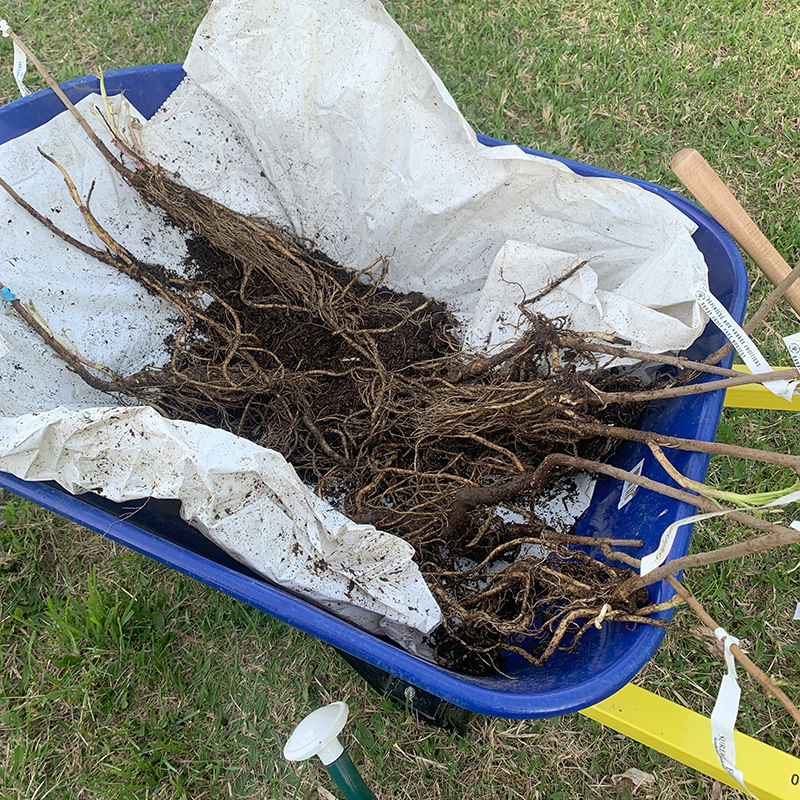 I then mixed this clay inside the wheel-barrow with several bags of cheap, all-purpose soil. Once this mix of soil was combined I moistened it and filled each hole back in to ensure the clay did not dry out before planting. I ensured all the earth worms I collected while digging the holes were added back into the holes as they are integral to improving soil health. After filling each hole back in, I created a small berm atop each, ensuring it was sloped to allow for eventual drainage.
I then mixed this clay inside the wheel-barrow with several bags of cheap, all-purpose soil. Once this mix of soil was combined I moistened it and filled each hole back in to ensure the clay did not dry out before planting. I ensured all the earth worms I collected while digging the holes were added back into the holes as they are integral to improving soil health. After filling each hole back in, I created a small berm atop each, ensuring it was sloped to allow for eventual drainage.Plants arrive
The day the Elderberry bare-roots arrived was very exciting. They looked barely more than twigs with roots. There was definitely a moment of worry as they did not look alive in any regards. However, they were in fact alive, just dormant. The roots were wrapped in plastic and tape, with a small amount of moist soil inside against the roots. Once I unwrapped them I knew I needed to get them in the ground quickly (I was aiming for under an hour) to ensure they didn't dry out. I was very nervous, so I did end up spraying the roots with water over the course of the hour. Since the holes had been dug out the day prior it was extremely easy to use a hand-spade and get them into the ground. The day prior I had not compacted the soil and so it was very simple.
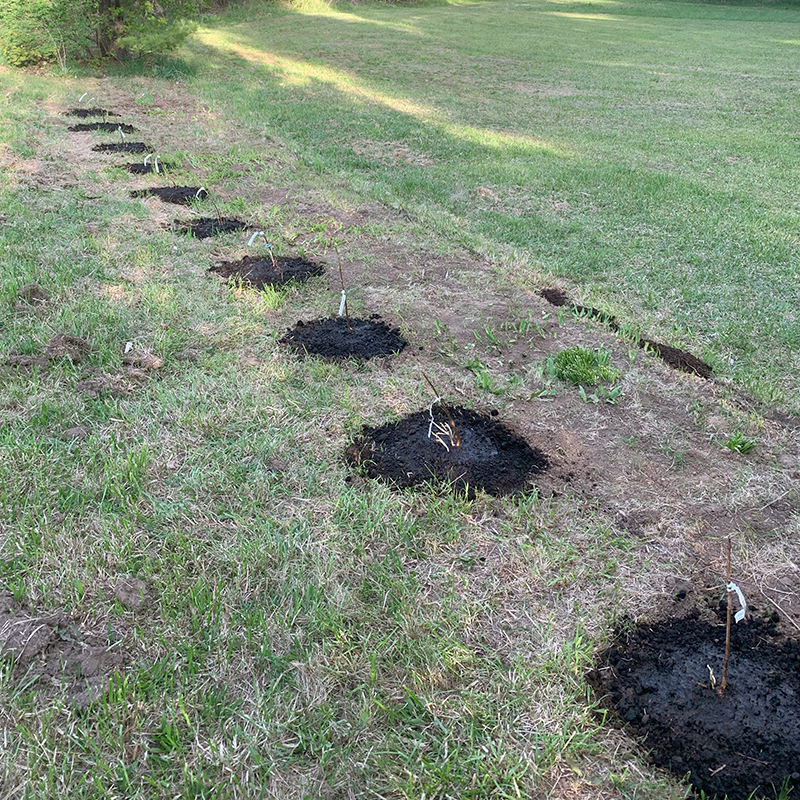
Planting
After inserting each bare-root plant I ensured it was straight and in the ground the correct depth, then used my hands to compress the soil down onto its roots to ensure it could remain up-right on its own. After getting all the bare-root plants in, I used my boots to compress the soil further. I had to add more of my native clay-soil mixture to the top of the planting area to recreate the drainage berm. The first delivery included 10 Elderberry bare-root plants - with Aronia and Seabuckthorn plants coming a few weeks later. After planting, compacting the soil, and building up a berm for each individual plant - I thoroughly watered each plant and used this as an opportunity to ensure that the berms were in fact draining with the natural slope of the plot. As the last step, I used shredded leaves and grass clippings as mulch to help lock in as much moisture as possible into the soil.
The first month after planting
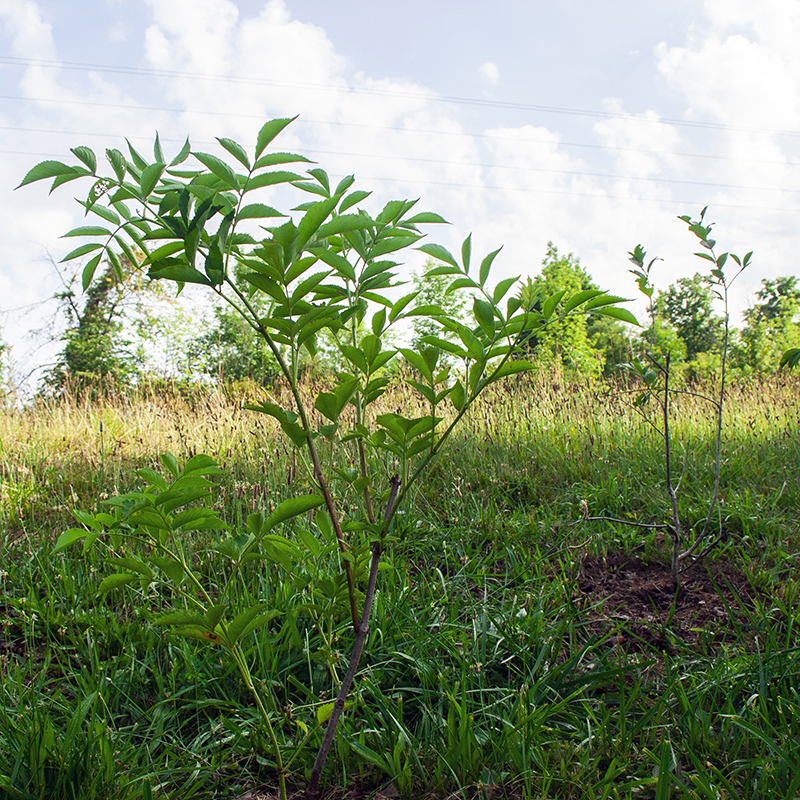 For the first 4 weeks I watered each plant every day (except for days when it rained). Within days of being planted they began to bud, and within a couple of weeks they all had extensive leaf growth. At the end of the first month many of the Elderberry plants grew from about 6" above soil to over 1' tall, literally doubling in height. The Seabuckthorn struggled initially, but by the end of the month quickly began to thrive. The Aronia, which arrived much taller than the other plants, did not seem to have any growth in the first month but also did not struggle from what I could see. I had to re-build up the mulch mixture several times as the first month progressed.
For the first 4 weeks I watered each plant every day (except for days when it rained). Within days of being planted they began to bud, and within a couple of weeks they all had extensive leaf growth. At the end of the first month many of the Elderberry plants grew from about 6" above soil to over 1' tall, literally doubling in height. The Seabuckthorn struggled initially, but by the end of the month quickly began to thrive. The Aronia, which arrived much taller than the other plants, did not seem to have any growth in the first month but also did not struggle from what I could see. I had to re-build up the mulch mixture several times as the first month progressed.
End of the summer: final observations
By the end of the summer most of the plants were 3-4' high. The few plants with shadier conditions did have less growth, but still progressed enough where I was happy with them. The Elderberry were by far the most impressive in terms of growth, and some even produced a limited amount of berries. The Elderberry and Aronia were a favourite of bugs and lost a fair share of leaves from caterpillars, but ultimately their growth outpaced the destruction. Given that this was the first bare-roots I had ever planted I was pleased that none of the plants died, although a few of the Seabuckthorns did come really close.
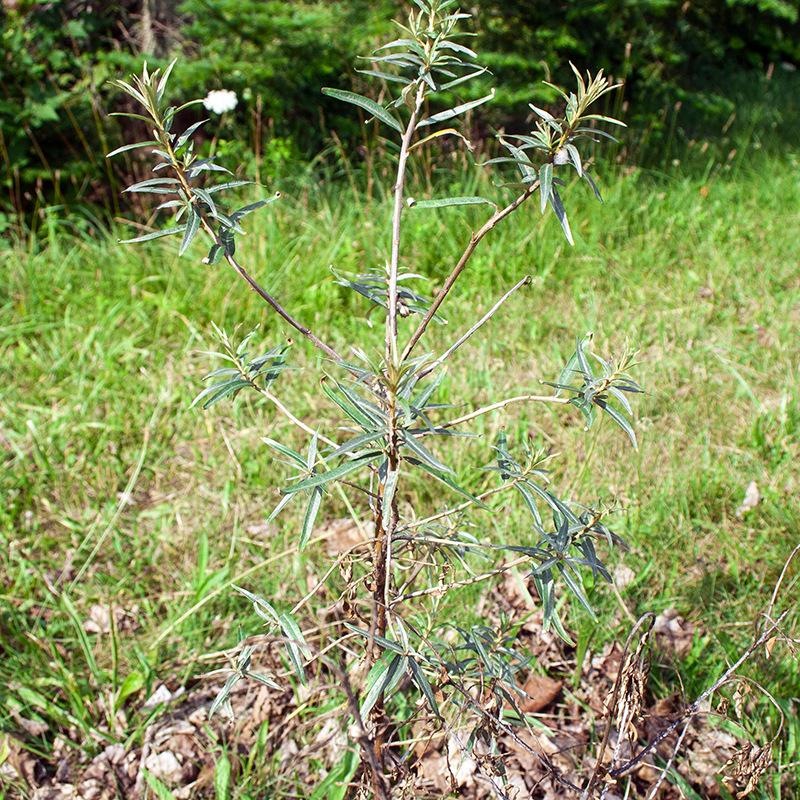 In hindsight, I do wish I had started with just the Elderberry plants as they seemed to have the most positive and immediate impact on the soil. I think if I had waited until year 2 for the other fruit shrubs that would have had an easier time. The Seabuckthorn really struggled in the full-light conditions and seemed to dry out quicker than I could water them. I think they would have benefited from a little bit more hours of shade a day and water retention from neighboring plants. As for the Aronia, it lost many leaves to critter and bug browse, and I do believe that would've been less had it been planted alongside more mature Elderberry plants. The bugs did seem to prefer the Elderberry plants in almost every regard and they were definitely more resilient to having their leaves chewed away than the Aronia was.
In hindsight, I do wish I had started with just the Elderberry plants as they seemed to have the most positive and immediate impact on the soil. I think if I had waited until year 2 for the other fruit shrubs that would have had an easier time. The Seabuckthorn really struggled in the full-light conditions and seemed to dry out quicker than I could water them. I think they would have benefited from a little bit more hours of shade a day and water retention from neighboring plants. As for the Aronia, it lost many leaves to critter and bug browse, and I do believe that would've been less had it been planted alongside more mature Elderberry plants. The bugs did seem to prefer the Elderberry plants in almost every regard and they were definitely more resilient to having their leaves chewed away than the Aronia was.
Additionally, the Elderberry plants were the most satisfying to watch grow as a newbie to this process and were absolutely prolific.